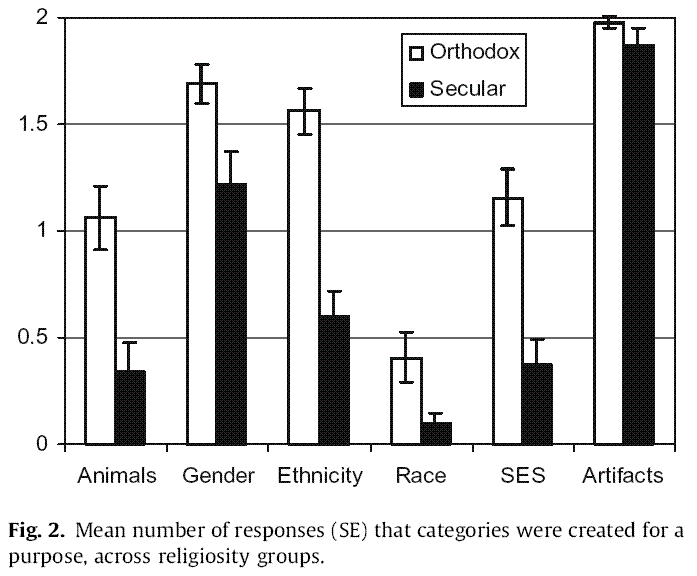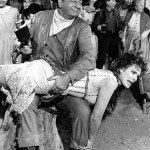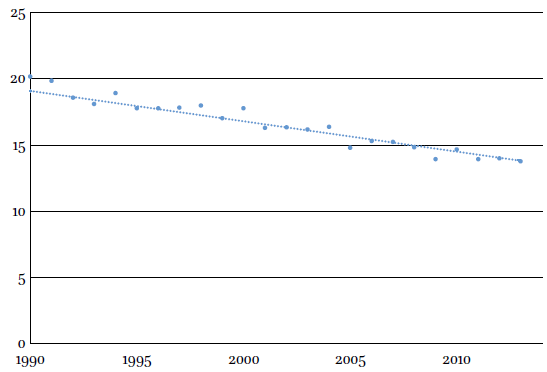You could make a reasonable case that pencils have a purpose, but pencil shavings just exist. But what about elephants? Religious people and children are, of course, more likely than non-religious adults to say that animals exist for a purpose.
But what about men and women? Black people and whites? Rich and poor? Arab and Jew? Do these exist for a purpose? And is it possible for one to become another? Gil Diesdendruck and Lital Haber of Bar-Ilan University in Israel decided to find out what children think.
They tested 64 Jewish girls and boys aged 7-12 years. Public education in Israel is heavily segregated, and they took half their sample from a secular school and half from an orthodox school. Each child was shown a series of picture pairs – animals (elephants and lions), artefacts (chairs and tables), ethnicity (Arabs and Jews), sex (men and women), race (black and white), and wealth (rich and poor). They were then shown a little story, in which two dolls discussed whether these different categories exist for a purpose, e.g., ‘‘Danny says that rich people exist for a purpose. Yossi says that rich people exist for no purpose, they just exist”. The children were then asked who was right.
They were then shown a little story, in which two dolls discussed whether these different categories exist for a purpose, e.g., ‘‘Danny says that rich people exist for a purpose. Yossi says that rich people exist for no purpose, they just exist”. The children were then asked who was right.
There were big differences between the two groups, shown in the figure here. Orthodox kids were much more likely to say that Arabs and Jews exist for a specific purpose, as do blacks and whites and, revealingly, rich and poor.
In other words, they think that all these types exist because they have a specific role to play, usually mandated by god. You can see here the seed of adult-life social conservatism.
They also asked the kids whether it was possible for one type to become another. Whether an Arab could become a Jew, or a poor person become rich. While they broadly agreed on animals, artefacts, and wealth, orthodox kids were more likely to say that sex, race and ethnicity are fixed (they have ‘essential’ properties).
These differences become even more stark when you split the kids not according to whether they were orthodox or secular, but according to whether they thought that God had created each of the categories in question. Of course, orthodox kids were more likely to think this, but not all of them did (and, conversely, some secular kids did).
The kids who thought that god created race, ethnicity, and gender were significantly more likely to think that this categories were created for a purpose and also that they were stable (you can’t change from one to another). Although they thought that socio-economic status and animals were also created for a purpose, but weren’t more likely to think that these categories were stable.
Here’s what Diesendruck and Haber conclude:
… our findings indicate that children’s essentialist beliefs about animals, and their teleological construal of artifacts, come to them intuitively and independently of creationism. In turn, children’s extension of essentialism to particular social categories, and teleology to both social categories and animals, are reflective, and result from the communication of a culturally constituted belief system – i.e., creationism.
In other words, if you teach kids creationism – not just about animals, but about people – you train them to think that they have a specific purpose (in the same way that secular kids think about artefacts such as pencils, tables and chairs).
It’s no wonder, then, that they grow up to be social conservatives – fearing women and gay rights, accepting wide differences in social equality, and reinforcing the ethnic schisms within society.
![]() G DIESENDRUCK, L HABER (2009). God’s categories: The effect of religiosity on children’s teleological and essentialist beliefs about categories. Cognition, 110 (1), 100-114. DOI: 10.1016/j.cognition.2008.11.001
G DIESENDRUCK, L HABER (2009). God’s categories: The effect of religiosity on children’s teleological and essentialist beliefs about categories. Cognition, 110 (1), 100-114. DOI: 10.1016/j.cognition.2008.11.001














